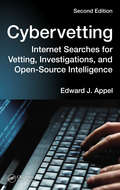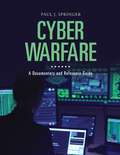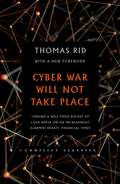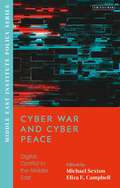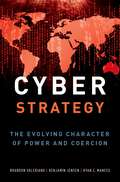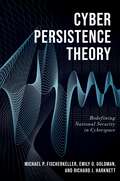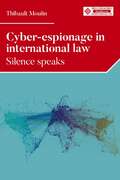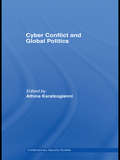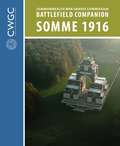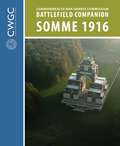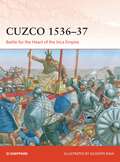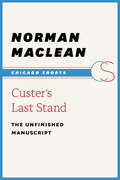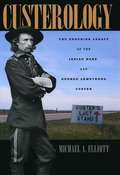- Table View
- List View
Cybervetting: Internet Searches for Vetting, Investigations, and Open-Source Intelligence, Second Edition
by Edward J. AppelResearching an individual‘s, firm‘s or brands online presence has become standard practice for many employers, investigators, and intelligence officers, including law enforcement. Countless companies and organizations are implementing their own policies, procedures, and practices for Internet investigations, cybervetting, and intelligence.
Cyber Warfare: A Documentary and Reference Guide (Documentary and Reference Guides)
by Paul J. SpringerProviding an invaluable introductory resource for students studying cyber warfare, this book highlights the evolution of cyber conflict in modern times through dozens of key primary source documents related to its development and implementation.This meticulously curated primary source collection is designed to offer a broad examination of key documents related to cyber warfare, covering the subject from multiple perspectives. The earliest documents date from the late 20th century, when the concept and possibility of cyber attacks became a reality, while the most recent documents are from 2019. Each document is accompanied by an introduction and analysis written by an expert in the field that provides the necessary context for readers to learn about the complexities of cyber warfare.The title's nearly 100 documents are drawn primarily but not exclusively from government sources and allow readers to understand how policy, strategy, doctrine, and tactics of cyber warfare are created and devised, particularly in the United States. Although the U.S. is the global leader in cyber capabilities and is largely driving the determination of norms within the cyber domain, the title additionally contains a small number of international documents. This invaluable work will serve as an excellent starting point for anyone seeking to understand the nature and character of international cyber warfare.
Cyber Warfare: A Documentary and Reference Guide (Documentary and Reference Guides)
by Paul J. SpringerProviding an invaluable introductory resource for students studying cyber warfare, this book highlights the evolution of cyber conflict in modern times through dozens of key primary source documents related to its development and implementation.This meticulously curated primary source collection is designed to offer a broad examination of key documents related to cyber warfare, covering the subject from multiple perspectives. The earliest documents date from the late 20th century, when the concept and possibility of cyber attacks became a reality, while the most recent documents are from 2019. Each document is accompanied by an introduction and analysis written by an expert in the field that provides the necessary context for readers to learn about the complexities of cyber warfare.The title's nearly 100 documents are drawn primarily but not exclusively from government sources and allow readers to understand how policy, strategy, doctrine, and tactics of cyber warfare are created and devised, particularly in the United States. Although the U.S. is the global leader in cyber capabilities and is largely driving the determination of norms within the cyber domain, the title additionally contains a small number of international documents. This invaluable work will serve as an excellent starting point for anyone seeking to understand the nature and character of international cyber warfare.
Cyber War Will Not Take Place
by Thomas Rid"Cyber war is coming," announced a land-mark RAND report in 1993. In 2005, the U.S. Air Force boasted it would now fly, fight, and win in cyberspace, the "fifth domain" of warfare. This book takes stock, twenty years on: is cyber war really coming? Has war indeed entered the fifth domain? Cyber War Will Not Take Place cuts through the hype and takes a fresh look at cyber security. Thomas Rid argues that the focus on war and winning distracts from the real challenge of cyberspace: non-violent confrontation that may rival or even replace violence in surprising ways. The threat consists of three different vectors: espionage, sabotage, and subversion. The author traces the most significant hacks and attacks, exploring the full spectrum of case studies from the shadowy world of computer espionage and weaponised code. With a mix of technical detail and rigorous political analysis, the book explores some key questions: What are cyber weapons? How have they changed the meaning of violence? How likely and how dangerous is crowd-sourced subversive activity? Why has there never been a lethal cyber attack against a country's critical infrastructure? How serious is the threat of "pure" cyber espionage, of exfiltrating data without infiltrating humans first? And who is most vulnerable: which countries, industries, individuals?
Cyber War Will Not Take Place
by Thomas Rid"Cyber war is coming," announced a land-mark RAND report in 1993. In 2005, the U.S. Air Force boasted it would now fly, fight, and win in cyberspace, the "fifth domain" of warfare. This book takes stock, twenty years on: is cyber war really coming? Has war indeed entered the fifth domain? Cyber War Will Not Take Place cuts through the hype and takes a fresh look at cyber security. Thomas Rid argues that the focus on war and winning distracts from the real challenge of cyberspace: non-violent confrontation that may rival or even replace violence in surprising ways. The threat consists of three different vectors: espionage, sabotage, and subversion. The author traces the most significant hacks and attacks, exploring the full spectrum of case studies from the shadowy world of computer espionage and weaponised code. With a mix of technical detail and rigorous political analysis, the book explores some key questions: What are cyber weapons? How have they changed the meaning of violence? How likely and how dangerous is crowd-sourced subversive activity? Why has there never been a lethal cyber attack against a country's critical infrastructure? How serious is the threat of "pure" cyber espionage, of exfiltrating data without infiltrating humans first? And who is most vulnerable: which countries, industries, individuals?
Cyber War and Cyber Peace: Digital Conflict in the Middle East (Middle East Institute Policy Series)
by Michael Sexton and Eliza CampbellThe Middle East is the region in which the first act of cyber warfare took place. Since then, cyber warfare has escalated and has completely altered the course of the MENA region's geopolitics.With a foreword by top national security and cyber expert, Richard A. Clarke, this is the first anthology to specifically investigate the history and state of cyber warfare in the Middle East. It gathers an array of technical practitioners, social science scholars, and legal experts to provide a panoramic overview and cross-sectional analysis covering four main areas: privacy and civil society; the types of cyber conflict; information and influence operations; and methods of countering extremism online. The book highlights the real threat of hacktivism and informational warfare between state actors and the specific issues affecting the MENA region. These include digital authoritarianism and malware attacks in the Middle East, analysis of how ISIS and the Syrian electronic army use the internet, and the impact of disinformation and cybercrime in the Gulf. The book captures the flashpoints and developments in cyber conflict in the past 10 years and offers a snapshot of the region's still-early cyber history. It also clarifies how cyber warfare may develop in the near- to medium-term future and provides ideas of how its greatest risks can be avoided.
Cyber War and Cyber Peace: Digital Conflict in the Middle East (Middle East Institute Policy Series)
The Middle East is the region in which the first act of cyber warfare took place. Since then, cyber warfare has escalated and has completely altered the course of the MENA region's geopolitics.With a foreword by top national security and cyber expert, Richard A. Clarke, this is the first anthology to specifically investigate the history and state of cyber warfare in the Middle East. It gathers an array of technical practitioners, social science scholars, and legal experts to provide a panoramic overview and cross-sectional analysis covering four main areas: privacy and civil society; the types of cyber conflict; information and influence operations; and methods of countering extremism online. The book highlights the real threat of hacktivism and informational warfare between state actors and the specific issues affecting the MENA region. These include digital authoritarianism and malware attacks in the Middle East, analysis of how ISIS and the Syrian electronic army use the internet, and the impact of disinformation and cybercrime in the Gulf. The book captures the flashpoints and developments in cyber conflict in the past 10 years and offers a snapshot of the region's still-early cyber history. It also clarifies how cyber warfare may develop in the near- to medium-term future and provides ideas of how its greatest risks can be avoided.
CYBER STRATEGY C: The Evolving Character of Power and Coercion
by Benjamin Jensen Brandon Valeriano Ryan C. ManessSome pundits claim cyber weaponry is the most important military innovation in decades, a transformative new technology that promises a paralyzing first-strike advantage difficult for opponents to deter. Yet, what is cyber strategy? How do actors use cyber capabilities to achieve a position of advantage against rival states? This book examines the emerging art of cyber strategy and its integration as part of a larger approach to coercion by states in the international system between 2000 and 2014. To this end, the book establishes a theoretical framework in the coercion literature for evaluating the efficacy of cyber operations. Cyber coercion represents the use of manipulation, denial, and punishment strategies in the digital frontier to achieve some strategic end. As a contemporary form of covert action and political warfare, cyber operations rarely produce concessions and tend to achieve only limited, signaling objectives. When cyber operations do produce concessions between rival states, they tend to be part of a larger integrated coercive strategy that combines network intrusions with other traditional forms of statecraft such as military threats, economic sanctions, and diplomacy. The books finds that cyber operations rarely produce concessions in isolation. They are additive instruments that complement traditional statecraft and coercive diplomacy. The book combines an analysis of cyber exchanges between rival states and broader event data on political, military, and economic interactions with case studies on the leading cyber powers: Russia, China, and the United States. The authors investigate cyber strategies in their integrated and isolated contexts, demonstrating that they are useful for maximizing informational asymmetries and disruptions, and thus are important, but limited coercive tools. This empirical foundation allows the authors to explore how leading actors employ cyber strategy and the implications for international relations in the 21st century. While most military plans involving cyber attributes remain highly classified, the authors piece together strategies based on observations of attacks over time and through the policy discussion in unclassified space. The result will be the first broad evaluation of the efficacy of various strategic options in a digital world.
Cyber Strategy: The Evolving Character of Power and Coercion
by Brandon Valeriano Benjamin Jensen Ryan C. ManessSome pundits claim cyber weaponry is the most important military innovation in decades, a transformative new technology that promises a paralyzing first-strike advantage difficult for opponents to deter. Yet, what is cyber strategy? How do actors use cyber capabilities to achieve a position of advantage against rival states? This book examines the emerging art of cyber strategy and its integration as part of a larger approach to coercion by states in the international system between 2000 and 2014. To this end, the book establishes a theoretical framework in the coercion literature for evaluating the efficacy of cyber operations. Cyber coercion represents the use of manipulation, denial, and punishment strategies in the digital frontier to achieve some strategic end. As a contemporary form of covert action and political warfare, cyber operations rarely produce concessions and tend to achieve only limited, signaling objectives. When cyber operations do produce concessions between rival states, they tend to be part of a larger integrated coercive strategy that combines network intrusions with other traditional forms of statecraft such as military threats, economic sanctions, and diplomacy. The books finds that cyber operations rarely produce concessions in isolation. They are additive instruments that complement traditional statecraft and coercive diplomacy. The book combines an analysis of cyber exchanges between rival states and broader event data on political, military, and economic interactions with case studies on the leading cyber powers: Russia, China, and the United States. The authors investigate cyber strategies in their integrated and isolated contexts, demonstrating that they are useful for maximizing informational asymmetries and disruptions, and thus are important, but limited coercive tools. This empirical foundation allows the authors to explore how leading actors employ cyber strategy and the implications for international relations in the 21st century. While most military plans involving cyber attributes remain highly classified, the authors piece together strategies based on observations of attacks over time and through the policy discussion in unclassified space. The result will be the first broad evaluation of the efficacy of various strategic options in a digital world.
Cyber Persistence Theory: Redefining National Security in Cyberspace (Bridging the Gap)
by Michael P. Fischerkeller Emily O. Goldman Richard J. HarknettA bold re-conceptualization of the fundamentals driving behavior and dynamics in cyberspace. Most cyber operations and campaigns fall short of activities that states would regard as armed conflict. In Cyber Persistence Theory, Michael P. Fischerkeller, Emily O. Goldman, and Richard J. Harknett argue that a failure to understand this strategic competitive space has led many states to misapply the logic and strategies of coercion and conflict to this environment and, thus, suffer strategic loss as a result. The authors show how the paradigm of deterrence theory can neither explain nor manage the preponderance of state cyber activity. They present a new theory that illuminates the exploitive, rather than coercive, dynamics of cyber competition and an analytical framework that can serve as the basis for new strategies of persistence. Drawing on their policy experience, they offer a new set of prescriptions to guide policymakers toward a more stable, secure cyberspace.
Cyber Persistence Theory: Redefining National Security in Cyberspace (Bridging the Gap)
by Emily O. Goldman Michael P. Fischerkeller Richard J. HarknettA bold re-conceptualization of the fundamentals driving behavior and dynamics in cyberspace. Most cyber operations and campaigns fall short of activities that states would regard as armed conflict. In Cyber Persistence Theory, Michael P. Fischerkeller, Emily O. Goldman, and Richard J. Harknett argue that a failure to understand this strategic competitive space has led many states to misapply the logic and strategies of coercion and conflict to this environment and, thus, suffer strategic loss as a result. The authors show how the paradigm of deterrence theory can neither explain nor manage the preponderance of state cyber activity. They present a new theory that illuminates the exploitive, rather than coercive, dynamics of cyber competition and an analytical framework that can serve as the basis for new strategies of persistence. Drawing on their policy experience, they offer a new set of prescriptions to guide policymakers toward a more stable, secure cyberspace.
Cyber-espionage in international law: Silence speaks (Melland Schill Studies in International Law)
by Thibault MoulinWhile espionage between states is a practice dating back centuries, the emergence of the internet revolutionised the types and scale of intelligence activities, creating drastic new challenges for the traditional legal frameworks governing them.This book argues that cyber-espionage has come to have an uneasy status in law: it is not prohibited, because spying does not result in an internationally wrongful act, but neither is it authorised or permitted, because states are free to resist foreign cyber-espionage activities. Rather than seeking further regulation, however, governments have remained purposefully silent, leaving them free to pursue cyber-espionage themselves at the same time as they adopt measures to prevent falling victim to it.Drawing on detailed analysis of state practice and examples from sovereignty, diplomacy, human rights and economic law, this book offers a comprehensive overview of the current legal status of cyber-espionage, as well as future directions for research and policy. It is an essential resource for scholars and practitioners in international law, as well as anyone interested in the future of cyber-security.
Cyber-espionage in international law: Silence speaks (Melland Schill Studies in International Law)
by Thibault MoulinWhile espionage between states is a practice dating back centuries, the emergence of the internet revolutionised the types and scale of intelligence activities, creating drastic new challenges for the traditional legal frameworks governing them.This book argues that cyber-espionage has come to have an uneasy status in law: it is not prohibited, because spying does not result in an internationally wrongful act, but neither is it authorised or permitted, because states are free to resist foreign cyber-espionage activities. Rather than seeking further regulation, however, governments have remained purposefully silent, leaving them free to pursue cyber-espionage themselves at the same time as they adopt measures to prevent falling victim to it.Drawing on detailed analysis of state practice and examples from sovereignty, diplomacy, human rights and economic law, this book offers a comprehensive overview of the current legal status of cyber-espionage, as well as future directions for research and policy. It is an essential resource for scholars and practitioners in international law, as well as anyone interested in the future of cyber-security.
Cyber-Conflict and Global Politics (Contemporary Security Studies)
by Athina KaratzogianniThis volume examines theoretical and empirical issues relating to cyberconflict and its implications for global security and politics. Taking a multidimensional approach to current debates in internet politics, the book comprises essays by leading experts from across the world. The volume includes a comprehensive introduction to current debates in the field and their ramifications for global politics, and follows this with empirical case studies. These include cyberconflict, cyberwars, information warfare and hacktivism, in contexts such as Sri Lanka, Lebanon and Estonia, the European Social Forum, feminist cybercrusades and the use of the internet as a weapon by ethnoreligious and socio-political movements. The volume presents the theoretical debates and case studies of cyberconflict in a coherent, progressive and truly multidisciplinary way. The book will be of interest to students of cyberconflict, internet politics, security studies and IR in general.
Cyber-Conflict and Global Politics (Contemporary Security Studies)
by Athina KaratzogianniThis volume examines theoretical and empirical issues relating to cyberconflict and its implications for global security and politics. Taking a multidimensional approach to current debates in internet politics, the book comprises essays by leading experts from across the world. The volume includes a comprehensive introduction to current debates in the field and their ramifications for global politics, and follows this with empirical case studies. These include cyberconflict, cyberwars, information warfare and hacktivism, in contexts such as Sri Lanka, Lebanon and Estonia, the European Social Forum, feminist cybercrusades and the use of the internet as a weapon by ethnoreligious and socio-political movements. The volume presents the theoretical debates and case studies of cyberconflict in a coherent, progressive and truly multidisciplinary way. The book will be of interest to students of cyberconflict, internet politics, security studies and IR in general.
CWGC Battlefield Companion Somme 1916
by Bloomsbury PublishingThe Battle of the Somme was the most devastating engagement in which British troops fought during the First World War. The 141 days of conflict saw 400,000 British and Commonwealth casualties, with 60,000 on the first day alone. Since the end of the war, the battlefield has become hallowed ground as visitors fall silent at the sight of the rows of white gravestones marking the resting place of tens of thousands of soldiers.Published in partnership with the Commonwealth War Graves Commission (CWGC), this is a thematic guide to about 30 locations on the Somme. Released as part of the commemorations of the anniversary of the battle, this a high quality, weather resistant battlefield companion, spiral bound and containing a map and battlefield trails. It suggests sites to visit, and reveals some of the lesser-known stories behind CWGC sites and the men and women they commemorate, providing a snapshot of the day's fighting and its casualties. This is an invaluable resource for anyone travelling to the Somme in this centenary year.
CWGC Battlefield Companion Somme 1916
by Bloomsbury PublishingThe Battle of the Somme was the most devastating engagement in which British troops fought during the First World War. The 141 days of conflict saw 400,000 British and Commonwealth casualties, with 60,000 on the first day alone. Since the end of the war, the battlefield has become hallowed ground as visitors fall silent at the sight of the rows of white gravestones marking the resting place of tens of thousands of soldiers.Published in partnership with the Commonwealth War Graves Commission (CWGC), this is a thematic guide to about 30 locations on the Somme. Released as part of the commemorations of the anniversary of the battle, this a high quality, weather resistant battlefield companion, spiral bound and containing a map and battlefield trails. It suggests sites to visit, and reveals some of the lesser-known stories behind CWGC sites and the men and women they commemorate, providing a snapshot of the day's fighting and its casualties. This is an invaluable resource for anyone travelling to the Somme in this centenary year.
Cuzco 1536–37: Battle for the Heart of the Inca Empire (Campaign)
by Si SheppardA highly illustrated and detailed study of one of the most important campaigns in the colonization of the Americas, the Spanish conquest of the vast Inca Empire.In April 1532 a bloody civil war between two brothers ended with one of them, Atahualpa, as master of the mighty Inca Empire. Now the most powerful man in South America, his word was law for millions of subjects spread across thousands of square miles, from the parched deserts of the coast to the lush rainforest of the Amazon and along the spine of the soaring Andes Mountains. But the time of the Incas was coming to an end. In November of that year a handful of Spanish conquistadors led by Francisco Pizarro seized Atahualpa at Cajamarca, extorted his treasure, murdered him, and then marched on the Inca capital Cuzco to elevate a puppet, Manco, to the vacant throne. In 1536, however, Manco roused his people against the intruders, and the Spaniards found themselves isolated and fighting for their lives. This fascinating and beautifully illustrated book brings to life the background to and progress of the desperate 10-month siege of Cuzco; the opposing commanders, their fighting men, tactics, and military technologies; the key clashes, from Sacsayhuamán to Ollantaytambo; and how the outcome shaped our world today.
Cuzco 1536–37: Battle for the Heart of the Inca Empire (Campaign #372)
by Si SheppardA highly illustrated and detailed study of one of the most important campaigns in the colonization of the Americas, the Spanish conquest of the vast Inca Empire.In April 1532 a bloody civil war between two brothers ended with one of them, Atahualpa, as master of the mighty Inca Empire. Now the most powerful man in South America, his word was law for millions of subjects spread across thousands of square miles, from the parched deserts of the coast to the lush rainforest of the Amazon and along the spine of the soaring Andes Mountains. But the time of the Incas was coming to an end. In November of that year a handful of Spanish conquistadors led by Francisco Pizarro seized Atahualpa at Cajamarca, extorted his treasure, murdered him, and then marched on the Inca capital Cuzco to elevate a puppet, Manco, to the vacant throne. In 1536, however, Manco roused his people against the intruders, and the Spaniards found themselves isolated and fighting for their lives. This fascinating and beautifully illustrated book brings to life the background to and progress of the desperate 10-month siege of Cuzco; the opposing commanders, their fighting men, tactics, and military technologies; the key clashes, from Sacsayhuamán to Ollantaytambo; and how the outcome shaped our world today.
The Cutty Sark Pocket Manual
by National Maritime Museum Arron Hewett Louise MacfarlaneConstructed on the Clyde in 1869 for the Jock Willis Shipping Line, Cutty Sark was one of the last tea clippers to be built and one of the fastest. Cutty Sark spent just a few years on the tea routes before the opening of the Suez Canal and the increasing use of steamships made clippers unprofitable on shorter routes. It was turned to the trade in wool from Australia, where for ten years she held the record time for a journey to Britain. After finishing her time in service as cargo ship, and then a training and cadet ship, it was transferred to permanent dry dock at Greenwich, London, for public display. This handy and illuminating pocket manual collates original documents to tell the fascinating story of how the legendary Cutty Sark was commissioned, her design and building, life on board and her notable journeys.
The Cutty Sark Pocket Manual
by National Maritime Museum Arron Hewett Louise MacfarlaneConstructed on the Clyde in 1869 for the Jock Willis Shipping Line, Cutty Sark was one of the last tea clippers to be built and one of the fastest. Cutty Sark spent just a few years on the tea routes before the opening of the Suez Canal and the increasing use of steamships made clippers unprofitable on shorter routes. It was turned to the trade in wool from Australia, where for ten years she held the record time for a journey to Britain. After finishing her time in service as cargo ship, and then a training and cadet ship, it was transferred to permanent dry dock at Greenwich, London, for public display. This handy and illuminating pocket manual collates original documents to tell the fascinating story of how the legendary Cutty Sark was commissioned, her design and building, life on board and her notable journeys.
The Cut Out Girl: A Story of War and Family, Lost and Found
by Bart Van Es'Luminous, elegant, haunting, - I read it straight through' Philippe Sands, Author of East West StreetThe enthralling story of a man's search for the truth about his family's pastThe last time Lien saw her parents was in the Hague when she was collected at the door by a stranger and taken to a city far away to be hidden from the Nazis. She was raised by her foster family as one of their own, but a falling out well after the war meant they were no longer in touch. What was her side of the story, Bart van Es - a grandson of the couple who looked after Lien - wondered? What really happened during the war, and after?So began an investigation that would consume and transform both Bart van Es's life and Lien's. Lien was now in her 80s and living in Amsterdam. Reluctantly, she agreed to meet him, and eventually they struck up a remarkable friendship. The Cut Out Girl braids together a powerful recreation of Lien's intensely harrowing childhood story with the present-day account of Bart's efforts to piece that story together. And it embraces the wider picture, too, for Holland was more cooperative in rounding up its Jews for the Nazis than any other Western European country; that is part of Lien's story too.This is an astonishing, moving reckoning with a young girl's struggle for survival during war. It is a story about the powerful love and challenges of foster families, and about the ways our most painful experiences - so crucial in defining us - can also be redefined.'Remarkable, deeply moving' Penelope Lively'An awe-inspiring account of the tragedies and triumphs within the world of the Holocaust's "hide-away" children, and of the families who sheltered them' Georgia Hunter'A complex and uplifting tale' Kirkus
Custer's Last Stand: The Unfinished Manuscript (Chicago Shorts)
by Norman MacleanIn his eighty-seven years, Norman Maclean played many parts: fisherman, logger, firefighter, scholar, teacher. But it was a role he took up late in life, that of writer, that won him enduring fame and critical acclaim—as well as the devotion of readers worldwide. When he died in 1990, Maclean left behind an earlier unfinished project, on a topic that had held his attention for decades: General Custer and the Battle of the Little Bighorn. The portions of that writing that remain reveal a deep interest not only in the battle itself but also its afterlife—how historical events influence popular culture and how retellings revise the past. Summarizing the events from the various perspectives of the Americans, the Sioux, and the Cheyenne, Maclean explains why the battle lives on in our imagination. Custer’s “last stand” provides all the elements—the characters, the plot, and the backdrop—of the perfect dramatic tragedy. And the way we retell history, argues Maclean, is intimately tied to how we choose to memorialize defeat.
Custerology: The Enduring Legacy of the Indian Wars and George Armstrong Custer
by Michael A. ElliottOn a hot summer day in 1876, George Armstrong Custer led the Seventh Cavalry to the most famous defeat in U.S. military history. Outnumbered and exhausted, the Seventh Cavalry lost more than half of its 400 men, and every soldier under Custer’s direct command was killed. It’s easy to understand why this tremendous defeat shocked the American public at the time. But with Custerology, Michael A. Elliott tackles the far more complicated question of why the battle still haunts the American imagination today. Weaving vivid historical accounts of Custer at Little Bighorn with contemporary commemorations that range from battle reenactments to the unfinished Crazy Horse memorial, Elliott reveals a Custer and a West whose legacies are still vigorously contested. He takes readers to each of the important places of Custer’s life, from his Civil War home in Michigan to the site of his famous demise, and introduces us to Native American activists, Park Service rangers, and devoted history buffs along the way. Elliott shows how Custer and the Indian Wars continue to be both a powerful symbol of America’s bloody past and a crucial key to understanding the nation’s multicultural present. “[Elliott] is an approachable guide as he takes readers to battlefields where Custer fought American Indians . . . to the Michigan town of Monroe that Custer called home after he moved there at age 10 . . . to the Black Hills of South Dakota where Custer led an expedition that gave birth to a gold rush."—Steve Weinberg, Atlanta Journal-Constitution “By ‘Custerology,’ Elliott means the historical interpretation and commemoration of Custer and the Indian Wars in which he fought not only by those who honor Custer but by those who celebrate the Native American resistance that defeated him. The purpose of this book is to show how Custer and the Little Bighorn can be and have been commemorated for such contradictory purposes.”—Library Journal “Michael Elliott’s Custerology is vivid, trenchant, engrossing, and important. The American soldier George Armstrong Custer has been the subject of very nearly incessant debate for almost a century and a half, and the debate is multicultural, multinational, and multimedia. Mr. Elliott's book provides by far the best overview, and no one interested in the long-haired soldier whom the Indians called Son of the Morning Star can afford to miss it.”—Larry McMurtry
Custerology: The Enduring Legacy of the Indian Wars and George Armstrong Custer
by Michael A. ElliottOn a hot summer day in 1876, George Armstrong Custer led the Seventh Cavalry to the most famous defeat in U.S. military history. Outnumbered and exhausted, the Seventh Cavalry lost more than half of its 400 men, and every soldier under Custer’s direct command was killed. It’s easy to understand why this tremendous defeat shocked the American public at the time. But with Custerology, Michael A. Elliott tackles the far more complicated question of why the battle still haunts the American imagination today. Weaving vivid historical accounts of Custer at Little Bighorn with contemporary commemorations that range from battle reenactments to the unfinished Crazy Horse memorial, Elliott reveals a Custer and a West whose legacies are still vigorously contested. He takes readers to each of the important places of Custer’s life, from his Civil War home in Michigan to the site of his famous demise, and introduces us to Native American activists, Park Service rangers, and devoted history buffs along the way. Elliott shows how Custer and the Indian Wars continue to be both a powerful symbol of America’s bloody past and a crucial key to understanding the nation’s multicultural present. “[Elliott] is an approachable guide as he takes readers to battlefields where Custer fought American Indians . . . to the Michigan town of Monroe that Custer called home after he moved there at age 10 . . . to the Black Hills of South Dakota where Custer led an expedition that gave birth to a gold rush."—Steve Weinberg, Atlanta Journal-Constitution “By ‘Custerology,’ Elliott means the historical interpretation and commemoration of Custer and the Indian Wars in which he fought not only by those who honor Custer but by those who celebrate the Native American resistance that defeated him. The purpose of this book is to show how Custer and the Little Bighorn can be and have been commemorated for such contradictory purposes.”—Library Journal “Michael Elliott’s Custerology is vivid, trenchant, engrossing, and important. The American soldier George Armstrong Custer has been the subject of very nearly incessant debate for almost a century and a half, and the debate is multicultural, multinational, and multimedia. Mr. Elliott's book provides by far the best overview, and no one interested in the long-haired soldier whom the Indians called Son of the Morning Star can afford to miss it.”—Larry McMurtry
